Squash is an easy-to-grow vegetable that enriches food by replacing high-calorie, low-nutrient foods. If you plan to grow this amazing crop in raised beds and need to learn how to space them, this article is the perfect guide.
In general, Space the seeds of the summer squash variety 12-18 inches apart, the transplants 15-20 inches apart, and the rows 4-6 feet apart. Space the seeds of the winter squash variety 10 inches apart, the transplants 12-15 inches apart, and the rows 6-12 feet apart.
This guide will explain how far apart you should plant squash in a raised garden bed. This article will also discuss everything you need to know about growing squash in raised beds. So keep reading.
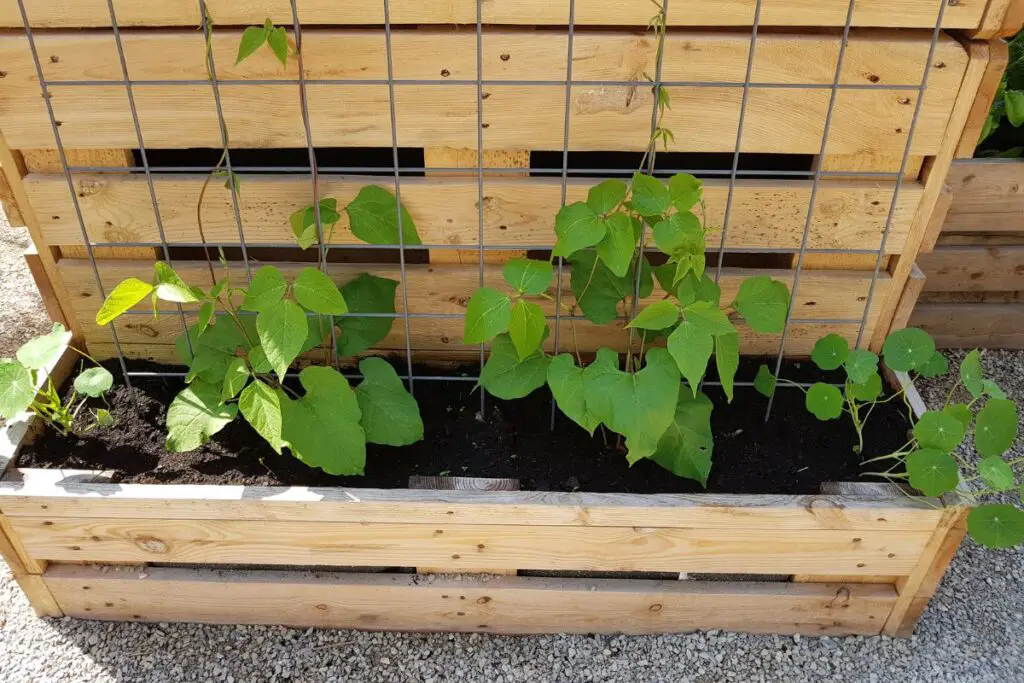
What will happen if you plant squash too close in a raised bed?
The squash plants require plenty of space to spread their roots and stems.
If you space them incorrectly, they might start to suffer from the following problems:
Nutrient deficiencies
The overcrowded squash plants will start competing for soil nutrients, which might increase fertilizer requirements.
Lack of sufficient nutrition will result in weak or yellow foliage, stunted growth, and lowered fruit production.
Hence, it is important to space the plant appropriately.
Pest and diseases
If the squash plants are spaced too close, there will be poor air circulation around them which might increase the risk of pests and diseases.
So, it’s crucial to space the squash properly to let the air move freely between the plants, which will help dry the leaves and prevent fungal infections.
Moisture problem
The raised garden bed might dry out quickly when too many plants try to absorb the soil’s moisture simultaneously.
In such a condition, you should frequently water the raised bed’s soil to maintain the moisture level.
Therefore, proper spacing is important to avoid such issues.
What are the different varieties of squash?
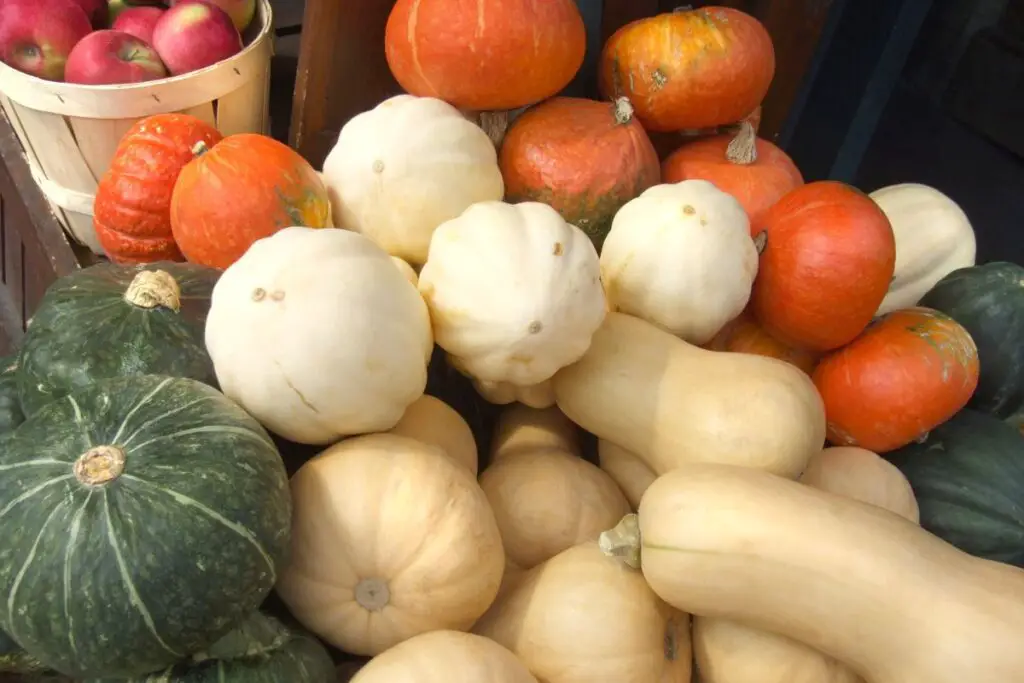
How far the squash should be spaced in a raised bed will depend on the plant variety you want to grow.
There are two most popular squash varieties, i.e., summer and winter.
Let us now discuss the difference between them.
| Summer squash | Winter squash |
|---|---|
| The summer squash includes all the bush squash varieties. | The winter squash includes all the vine squash varieties. |
| They grow quickly, take around 60 days to fully mature, and are harvested throughout the summers. | They grow slowly and take around 80-110 days to fully mature before harvesting. |
| They have soft skin, which is more tender and moist. | They have a hard shell, so they are ideal for storing throughout winter. |
| The plants grow upright in bushes, so they use more space in the raised beds. | The plants grow sprawling vines in a specific direction, maximizing your raised bed space. |
| Summer squash plants are more suitable for gardens and fields than raised beds. | Winter squash plants are more suitable for raised beds or hills than gardens. |
| Some summer squash varieties are straight-neck, crooked-neck, scallop, and zucchini. | Some of the winter squash varieties are Hubbard, spaghetti, and acorn. |
Looking for gardening supplies? We have tested 100's of products before recommending them to you guys. Check out our best pick below:
| Image | Gardening Supplies | Best Price? |
|---|---|---|
 Top
Top Top
Top | Raised Garden Bed Kit | Check On Amazon |
 | XLUX Soil Moisture Meter, Plant Water Monitor, Soil Hygrometer Sensor for Gardening, Farming, Indoor and Outdoor Plants, No Batteries Required | No Results |
 Top
Top Top
Top | 82 Pcs Garden Tools Set and Extra Succulent Tools Set | Check On Amazon |
 | Joeys Garden Expandable Garden Hose with 8 Function Hose Nozzle, Lightweight Anti-Kink Flexible Garden Hoses, Extra Strength Fabric with Double Latex Core, (50 FT, Black) | No Results |
 Top
Top Top
Top | Dual Chamber Compost Tumbler | Check On Amazon |
 Top
Top Top
Top | Sunnyglade Plant Stakes | Check On Amazon |
 Top
Top Top
Top | Organic Cold Pressed Neem Seed Oil | Check On Amazon |
 Top
Top Top
Top | Mighty Mint Gallon :-Insect and Pest Control Peppermint Oil | Check On Amazon |
 Top
Top Top
Top | Scotts DiseaseEx Lawn Fungicide | Check On Amazon |
 Top
Top Top
Top | Jacks Classic 20-20-20 All Purpose Fertilizer | Check On Amazon |
 Top
Top Top
Top | 30,000 Seeds Pollinator Attracting Wildflower Mixture | Check On Amazon |
 Top
Top Top
Top | Survival Vegetable Seeds Garden Kit-Over 16,000 Seeds | Check On Amazon |
Should I grow squash from seeds or transplants in raised beds?
You can grow squash from seeds and transplants in a raised garden bed.
However, growing squash from transplants is easier as compared to seeds.
Squash from seeds will take time to mature and usually demands more care and attention than transplants.
Still, if you want to grow squash from seeds, start by soaking the seeds overnight and plant 3-6 seeds in a cluster.
Once the seeds start sprouting, select the strongest seedlings and discard the rest.
When the seedlings have their first set of leaves, mulch the soil to retain the moisture.
But, if you don’t want to raise squash from seeds, you can purchase a few starter plants from a nearby nursery or start the seedlings indoors and transplant them into your raised garden bed.
How should you space squash in a raised bed?
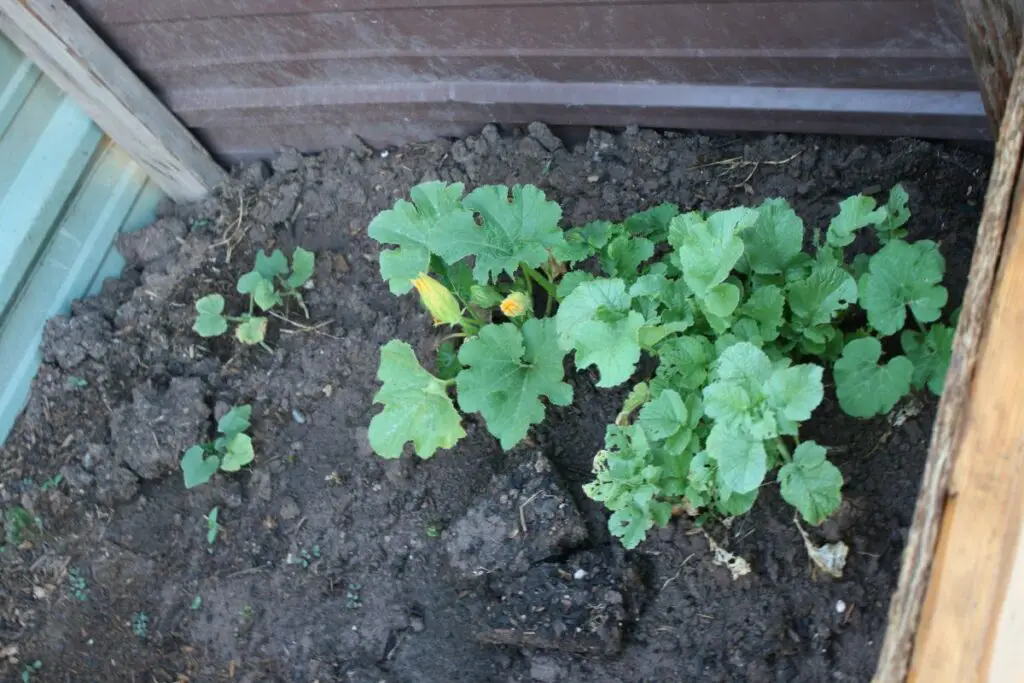
Squash plants need a lot of space to grow and thrive.
But how far apart you need to space the plants in a raised garden bed depends on your choice of squash.
Whether it’s a summer or winter variety, you need to give the roots enough space to grow to their full potential.
Let us discuss the spacing requirements for each of these varieties.
Spacing requirements for the summer variety (bush squash)
If growing the bush variety in raised beds, start by sowing the seeds 1 inch deep and space those 12-18 inches apart and the rows 4-6 feet apart.
Later, thin the seedlings out 3 feet apart.
If you don’t want to sow the seeds directly in the raised beds, you can start the seedlings at home.
Transplant the seedlings in the raised bed when it has a few sets of leaves.
Space the seedlings 15-20 inches apart and the rows 4-6 feet apart.
The bush varieties are planted at closer row spacing, so there are chances that the plants might start to compete with each other for resources.
Due to this reason, you need to fertilize and water the plants frequently.
Otherwise, they will produce small fruits, decreasing their overall productivity.
Spacing for the winter variety (vine variety)
If you want to grow the vine variety from seeds in raised beds, start by sowing the seeds 1 inch deep and space those 10-12 inches apart.
Space the rows 6-12 feet apart.
Thin the seedling in rows to 3 feet apart.
If you want to grow the squash directly from the seedlings, start by spacing those 12-15 inches apart and the rows 6-12 feet apart.
It’s important to space the vine variety far apart from each other to prevent overcrowding; otherwise, they will start growing into a tangled mass of vines.
The tangles vines will not be able to receive sufficient light and thus will reduce the size and the quality of the fruits.
How should you space squash on a raised hill?
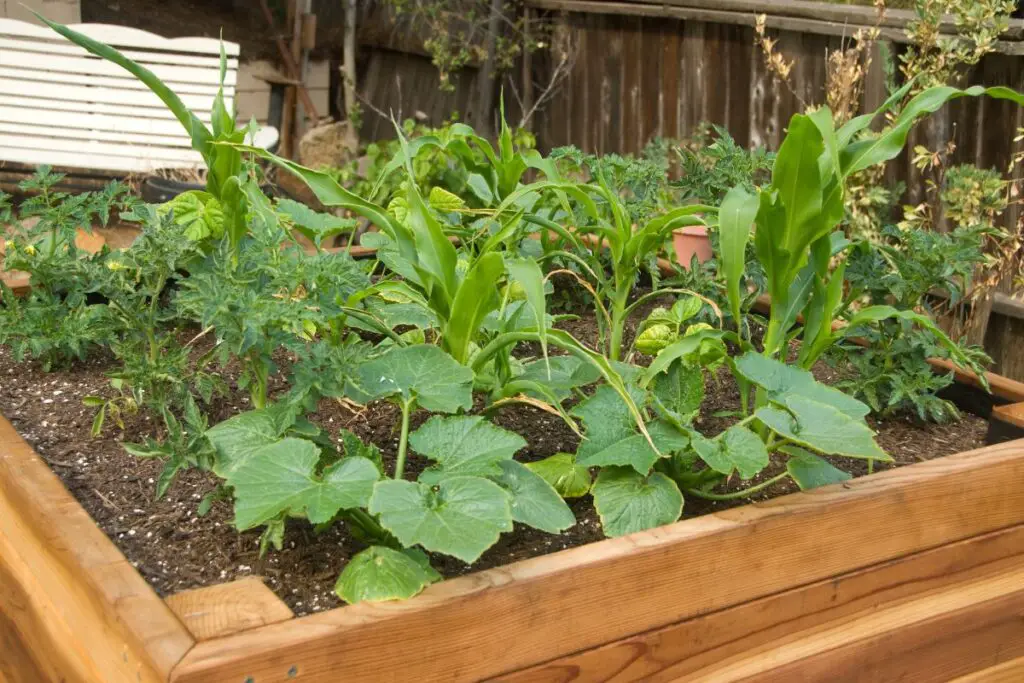
You can grow summer squash by planting seeds on a small hill, about 1 foot across.
Growing the plants in raised hills will give them better drainage and air circulation.
Plant the squash in clusters or hills when the soil is warm.
Start by sowing 5-6 seeds 1 and ½ inches deep and space those 2 inches apart.
The hill should be spaced 6 inches apart.
Like raised beds, one advantage of raised hills is that it doesn’t promote overwatering because of their good drainage system.
Mistakes you should avoid while growing squash in raised beds
Do you know one squash plant can produce 5 to 20 pounds of fruits?
It sounds interesting, but there’s a lot of hard work to get the fruits.
The growing condition and care will greatly impact the amount of squash you will obtain from one plant.
A single mistake while growing the squash might affect the whole productivity, so it’s crucial to be very careful while raising the plants.
Below, I will discuss some common mistakes you should avoid while raising this crop.
1. Choosing the wrong variety
One common mistake we all do is choosing the wrong squash variety for the place we live.
Summer squash grows in warm conditions and takes only two months to be prepared for harvest.
On the other hand, the winter squash handles cool temperatures and takes longer to fully mature for harvest.
If you live in a place with a shorter growing season, you will only be able to raise winter squash if you have a greenhouse arrangement.
Hence, it’s important to consider the growing situation before choosing the squash variety.
2. Planting at the wrong time
Another common mistake is when we plant squash in the wrong season.
Squash will only thrive well if you plant them at the right time.
If you plant the squash too early, they will not get the warmth to nurture themselves.
On the other hand, if you plant the squash too late, it might get damaged by the cold weather.
To avoid this mistake, plant the summer squash only when the threats of frost have passed and the temperatures are around 70°F.
The winter squash needs at least 100 days of no frost to be ready for harvest.
Therefore, you must decide on the expected frost date and plant the crop accordingly.
3. Making use of inappropriate soil
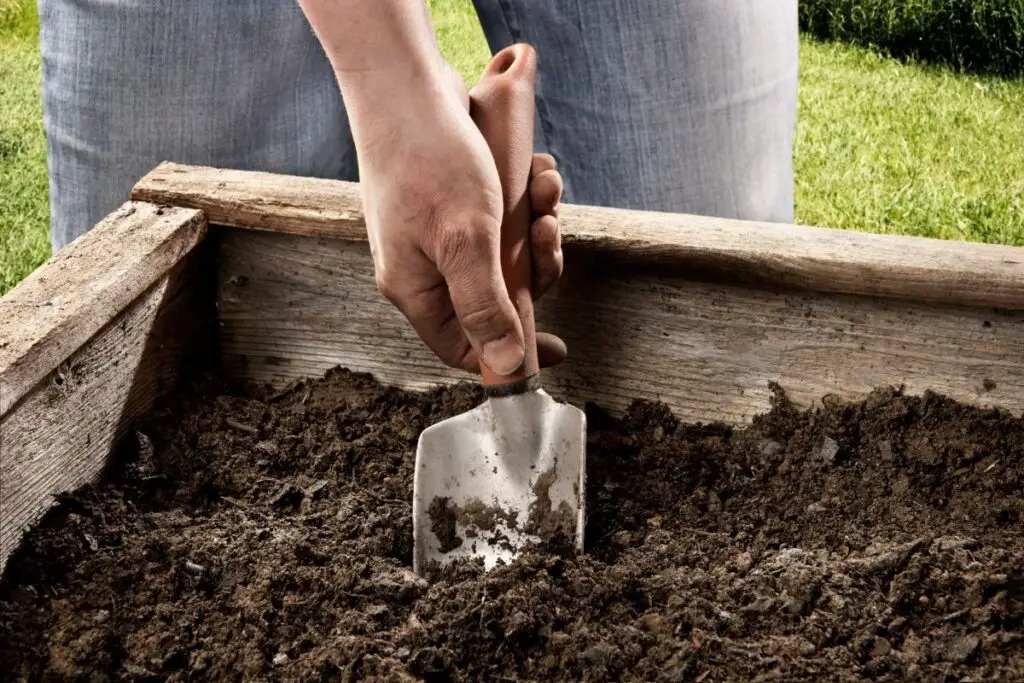
The soil for squash should be rich in nutrients, well-aerated, well-drained, and slightly acidic.
The pH level of the soil should be between 6.0 and 6.8.
Choosing a soil composition that lacks nutrients can severely damage squash productivity.
Therefore, it is important to amend the soil with fertilizers before planting the squash.
Also read: 7 Best DIY Raised Bed Soil Mix: A Step-by-step Guide
4. Not spacing the squash adequately
Since squash plants need plenty of space to grow, it’s really important not to space the plants very closely.
If you don’t space the plants properly, they will start competing with nutrients and starve each other out.
Different squash plants will have different spacing requirements.
Generally, the squash plants need 3 feet of spacing between plants and rows.
5. Not watering the crops properly
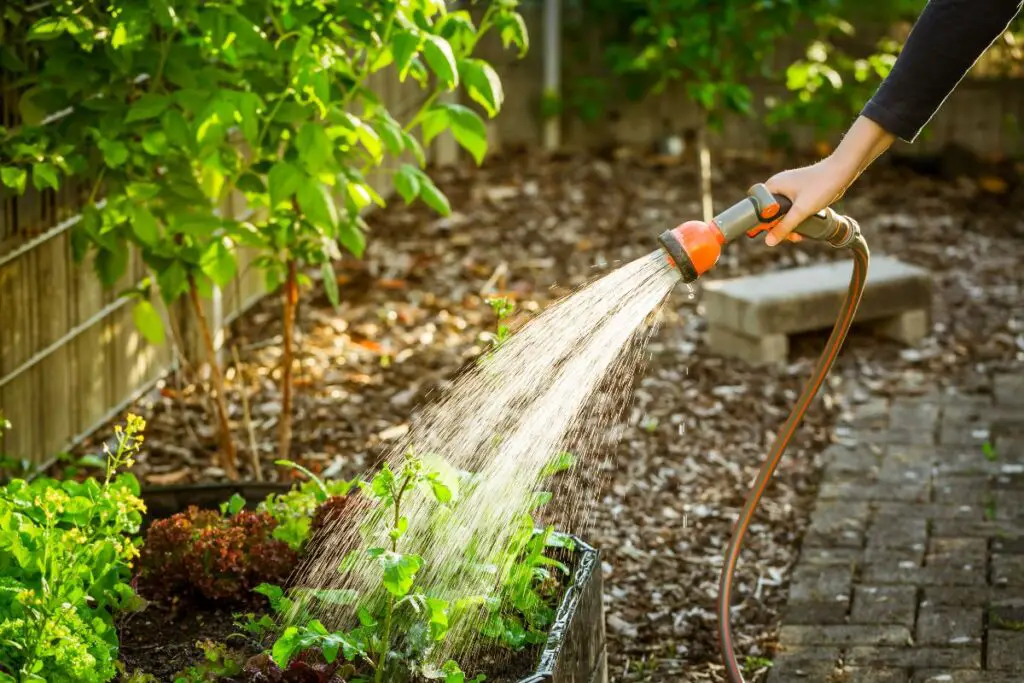
Squash plants are pretty thirsty plants.
They need lots of watering, so it is crucial to ensure they are watered enough.
Watering is one common area where we mostly do mistakes.
Not only underwatering but overwatering can also cause various issues to the plants.
Too much watering around the base of the stem will result in root rot disease.
However, the plants are less likely to get overwatered in raised beds because of the effective drainage system.
Underwatering is more likely to occur since the raised bed soil dries out quickly.
To avoid this mistake, always water the plant at the base, directly into the soil, and not from above.
Practice the deep watering method so the plants stay hydrated for longer.
Use a good organic mulch around plants so that the water from the soil doesn’t splash on the leaves.
Always water the plants early in the day so that the plants get enough time to dry.
6. Neglecting pests and diseases
When we grow many plants together, we might need help managing them effectively.
We may not see the pests on the plants, and soon later, we get upset with the declining health of our plants.
Pests and diseases can infect the plants in a very short time and can demolish our whole garden.
Squash plants are most prone to diseases like bacterial wilt, blossom end rot, and fungal diseases.
Regarding pests, squash plants are not safe from aphids, vine borers, squash bugs, and cucumber beetles.
You can treat pests and diseases with the help of fungicides and pesticides.
You also need to avoid overwatering the plants and make sure there is enough airflow around them.
7. Not fertilizing the plants enough
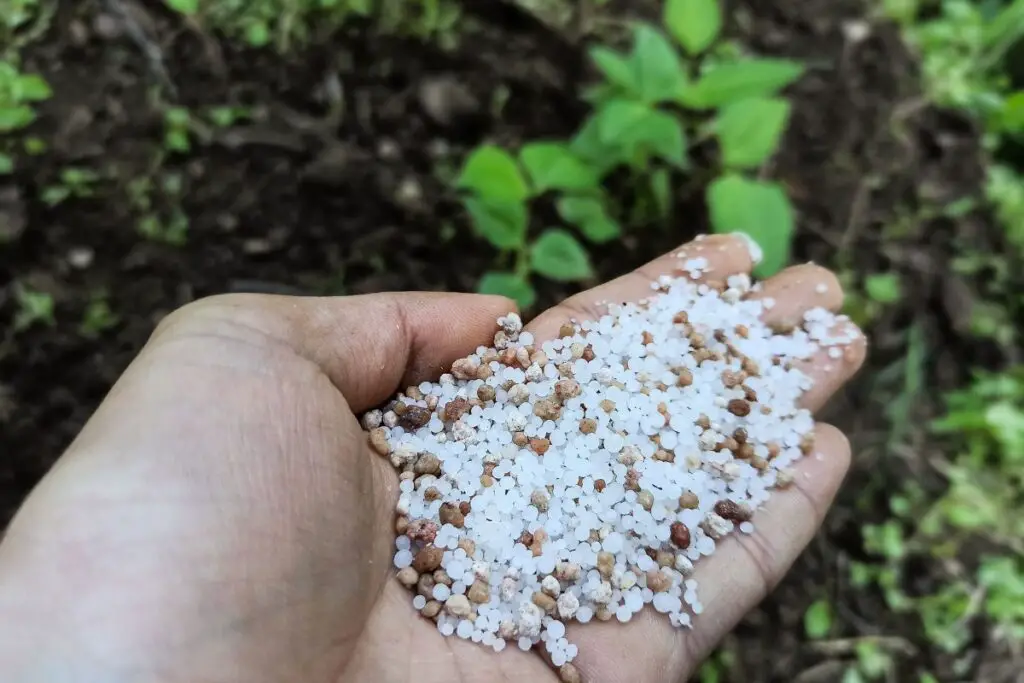
Squash are heavy feeders, so they need good rich, fertile soil for making fruits.
The soil needs to be amended before planting, but more is needed to provide the plants with nutrients throughout the growing season.
The plants take up nutrients very quickly from the soil, so you need to replenish the soil fertility from time to time.
Without sufficient nutrients, the plants will not stay healthy and will lose vigor.
You can avoid this mistake by fertilizing the plants with a well-balanced liquid fertilizer twice during the growing season.
You can increase the fertility of the soil by amending it with well-rotted manure and homemade compost.
8. The plants are provided with enough sunlight
Squash plants grow well when they get plenty of direct sunlight.
In poor sunlight, the plants fail to carry out the photosynthesis process, which results in poor health and low productivity.
It’s important to build a raised bed in that garden area that provides them with proper sunlight.
Ensure the plants get a minimum of 6-8 hours of direct sunlight daily.
9. Harvesting at the wrong time
Knowing when and how to harvest the squash fruits is necessary.
If you harvest the fruits at the right time or in the right way, you will retain your yield.
Different squash varieties will give you different signs when the harvest is near.
The summer squash should be harvested when they are young and tender and when they become 4 to 6 inches long.
You must catch the correct harvesting time if the squash becomes dark yellow, large, or lumpy.
In contrast, the winter squash should be harvested when the outer layer of the fruits becomes tough.
Make sure to use sharp and sterilized pruners for harvesting the fruits.
Reference: ScienceDirect, American Society of Agronomy, Noble Research Institute, Soil for Raised Beds, Raised Bed Gardening, Tomatoes in the Garden.
